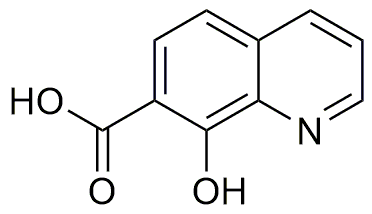8-Hydroxyquinoline-7-carboxylic acid is widely utilized in research focused on:
- Metal Ion Chelation: This compound is effective in forming stable complexes with metal ions, making it valuable in analytical chemistry for detecting and quantifying metals in various samples.
- Pharmaceutical Development: It serves as a key intermediate in the synthesis of pharmaceuticals, particularly in developing anti-inflammatory and antimicrobial agents.
- Biological Research: The compound is used in studies related to cell signaling and enzyme inhibition, providing insights into metabolic pathways and potential therapeutic targets.
- Corrosion Inhibition: Its properties allow it to be used in coatings and treatments to prevent corrosion in metals, particularly in the automotive and aerospace industries.
- Fluorescent Probes: The compound is employed in the development of fluorescent probes for biological imaging, enhancing the visualization of cellular processes.
General Information
Properties
Safety and Regulations
Applications
8-Hydroxyquinoline-7-carboxylic acid is widely utilized in research focused on:
- Metal Ion Chelation: This compound is effective in forming stable complexes with metal ions, making it valuable in analytical chemistry for detecting and quantifying metals in various samples.
- Pharmaceutical Development: It serves as a key intermediate in the synthesis of pharmaceuticals, particularly in developing anti-inflammatory and antimicrobial agents.
- Biological Research: The compound is used in studies related to cell signaling and enzyme inhibition, providing insights into metabolic pathways and potential therapeutic targets.
- Corrosion Inhibition: Its properties allow it to be used in coatings and treatments to prevent corrosion in metals, particularly in the automotive and aerospace industries.
- Fluorescent Probes: The compound is employed in the development of fluorescent probes for biological imaging, enhancing the visualization of cellular processes.
Documents
Safety Data Sheets (SDS)
The SDS provides comprehensive safety information on handling, storage, and disposal of the product.
Product Specification (PS)
The PS provides a comprehensive breakdown of the product’s properties, including chemical composition, physical state, purity, and storage requirements. It also details acceptable quality ranges and the product's intended applications.
Certificates of Analysis (COA)
Search for Certificates of Analysis (COA) by entering the products Lot Number. Lot and Batch Numbers can be found on a product’s label following the words ‘Lot’ or ‘Batch’.
*Catalog Number
*Lot Number
Certificates Of Origin (COO)
This COO confirms the country where the product was manufactured, and also details the materials and components used in it and whether it is derived from natural, synthetic, or other specific sources. This certificate may be required for customs, trade, and regulatory compliance.
*Catalog Number
*Lot Number
Safety Data Sheets (SDS)
The SDS provides comprehensive safety information on handling, storage, and disposal of the product.
DownloadProduct Specification (PS)
The PS provides a comprehensive breakdown of the product’s properties, including chemical composition, physical state, purity, and storage requirements. It also details acceptable quality ranges and the product's intended applications.
DownloadCertificates of Analysis (COA)
Search for Certificates of Analysis (COA) by entering the products Lot Number. Lot and Batch Numbers can be found on a product’s label following the words ‘Lot’ or ‘Batch’.
*Catalog Number
*Lot Number
Certificates Of Origin (COO)
This COO confirms the country where the product was manufactured, and also details the materials and components used in it and whether it is derived from natural, synthetic, or other specific sources. This certificate may be required for customs, trade, and regulatory compliance.


